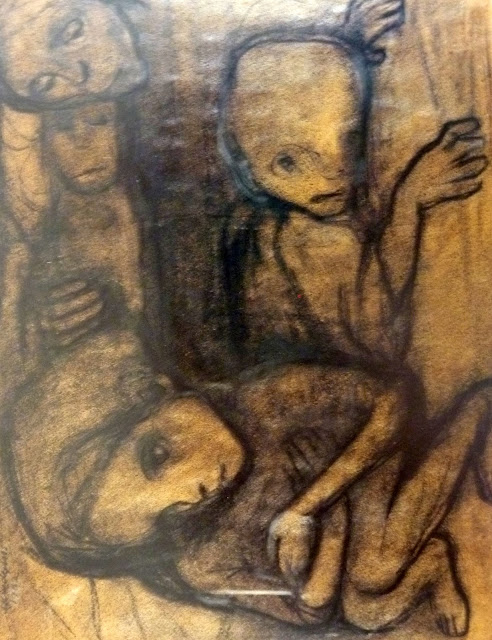While writing up the post Hunger yesterday, I was reminded of Anna Kindyny whose work was exhibited in the Benaki Museum in 2009.
All the major events in Anna Kindyny's life run parallel to all the major events in Greece's history. She was two months old when her family had to leave Asia Minor in Turkey when all the resident Greeks were persecuted and expelled. 'I was two months' old when we had to leave our home and took refuge in the mountains, half naked, without water or food, and we stayed there for 3 nights. We then found a boat that took us to Lesbos', she recounted. In 1917-18, when she was 4 years old, the German submarines besieged the Ionian islands and hunger hit the people there: she could see from her balcony all the emaciated dead being taken away: 'most days our only food was a handful of raisins', she remembered. Her family were able to return to Turkey in 1919 but had to leave again in 1922 when the Greek residents were all forced to flee the country: Anna was eight. Back to Lesbos. She moved to Athens in 1939 in search of work, and married in 1940.
The German occupation of Greece meant persecutions, mass executions, concentration camps and the awful hunger of 1941-42. She worked for the City Council and her job was to record the deaths of those who died from starvation. One of her sisters died from malnutrition. Kindyny and her husband moved to Paris in 1945 and she stayed there for 45 years. In 1947 her other sister, Irini, a political activist, was arrested and sent to exile to an arid island in the Aegean where she stayed for 4 years. Anna Kindyny found this very hard to bear and years later, did a whole series of sketches titled 'Women in Exile'.
She went to University in Paris and her friends included Braque, Picasso, Mondrian, Malevich and Kadinsky. Throughout her life she was politically active, and that included the uprising of May '68 as well as the feminist movement.
She was never able to forget the hunger of people in Athens during WWII and most of her work is influenced by those years: 'I had to recount my history and the history of my people. I used to sketch as if I was having a conversation with myself, a testimony, a confession....'
Despairing Motherhood, 1950s
Greece in 1941, 1950
Hunger, 1950s
Child, 1950s
'I saw this. This is how it happened', wrote Goya when referring to his masterpiece, Images of War.
It's the same with Anna Kindyny. Her work is a testimony to what she saw, what she experienced. The seemingly rough lines of her sketches, the dark tones, the silent, spectral forms, the tightly closed mouths of her haunting characters bear witness to what she saw and what she experienced. Her work is the recounting of the experiences of women, of female consciousness, of female suffering in a male-dominated world. Like Kathe Kollwitz's work, her work is about loss, suffering, and, ultimately, resistance.
Hungry Children, 1950s
Mother and Child, 1950s
Family of Immigrants, 1950s
Immigrants, 1950s
Bitter Motherhood, 1953
Hunger, 1954
Child, 1955
German Occupation, 1955
Unprotected, 1956
Hiroshima, 1956
Child, 1956
Abandonment, 1959
Child and Grandmother, 1962
Hungry, 1962
Eros, 1981
Eros, 1985
Finally, a photograph of the artist at work.























No comments:
Post a Comment